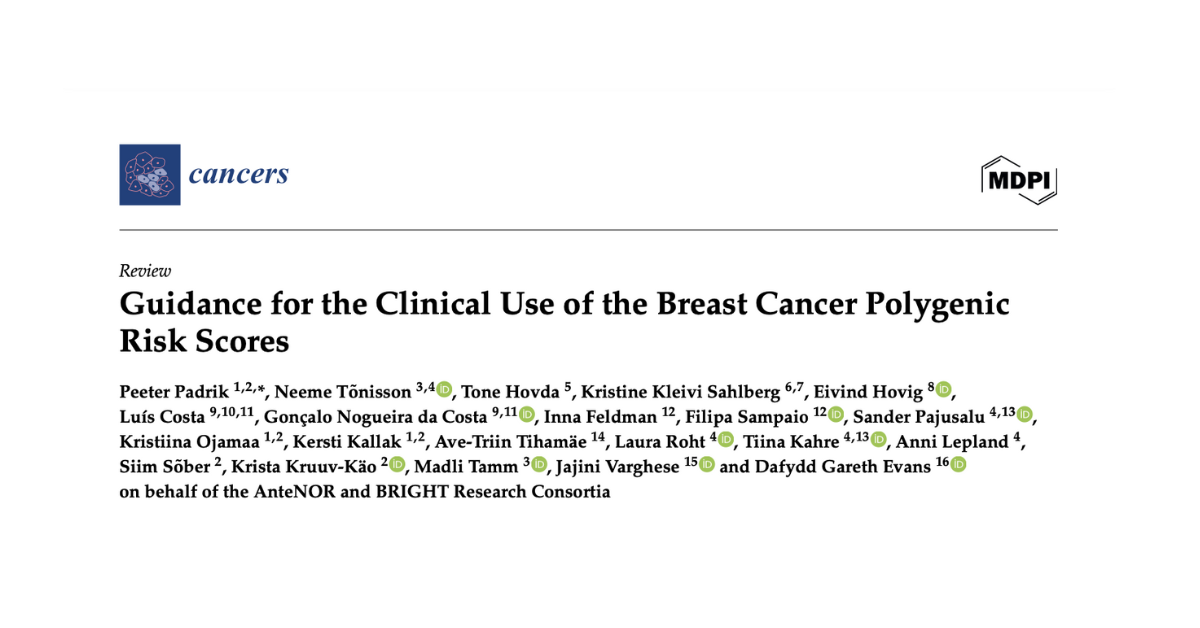An international public-private expert group from the UK and several European countries has published the first evidence-based clinical guidance on the use of polygenic risk scores (PRSs) for breast cancer risk. Published in the peer-reviewed journal Cancers, the guidance offers clear, actionable recommendations on how to integrate PRS testing into routine healthcare to enable personalised breast cancer prevention and screening.
- This new publication sets the standard, enabling more personalised and targeted breast cancer prevention and detection.
- It offers a clear framework for how healthcare systems, especially in Europe and the UK, can approach breast cancer risk and improve early detection.
- PRS testing reaches a broader population than rare variant testing and helps identify at-risk women under 50 — a group underrepresented in national screenings despite accounting for 1 in 5 breast cancer cases.
Polygenic risk scores are genomic tools that calculate an individual’s disease susceptibility based on the combined impact of multiple common genetic variants. In the case of breast cancer, PRSs can stratify women by their inherited risk level – supporting early detection, preventive strategies, and tailored screening schedules.
While PRSs have been extensively studied and are increasingly discussed in the context of predictive medicine, until now there has been no international clinical guidance outlining how and when to use PRS testing in healthcare. This new publication fills that gap.
“PRS testing empowers clinicians to offer earlier and more tailored prevention to women at higher risk – well before any symptoms appear,” says Dr Peeter Padrik, lead author and oncologist at Tartu University Hospital and health technology company Antegenes. “This is a landmark step for personalised medicine in breast cancer.”
Professor Gareth Evans, senior author of the article and Professor of Medical Genetics at the University of Manchester, notes that polygenic risk scores complement existing genetic testing by identifying risk in women who do not have rare pathogenic genetic variants in genes like BRCA1 or BRCA2 or a strong family history. “This guidance gives healthcare systems a structured way to use PRS information for more effective prevention and screening,” he says.
Co-author Dr. Jajini Varghese, Breast and Plastic Surgeon and Associate Professor at University College London, also comments: “This guidance reflects the growing consensus that we need to move toward personalised, risk-stratified screening. Polygenic risk tools can help us reach women who would otherwise be missed and support more informed, earlier interventions.”
The guidance details the clinical indications for using PRS testing in healthcare, including its application among healthy women with or without a family history of breast cancer, in hereditary cancer clinics, and within population-based screening programmes. It provides recommendations for interpreting PRS test results and combining them with other risk factors using established risk prediction models such as CanRisk and Tyrer–Cuzick, enhancing the accuracy of individual risk assessment.
In addition, the guidance aligns PRS-based recommendations with existing national practices and guidelines, including the UK’s NICE guidelines, as well as clinical practices in Germany, Sweden, Norway, Portugal, and Estonia. It also addresses key considerations for practical implementation, including regulatory compliance under the EU In Vitro Diagnostic Medical Devices Regulation (IVDR). It emphasises the importance of ensuring equitable access and performance across diverse populations.
The clinical guidelines are particularly timely in the UK, as the recently formed expert consortium has launched personalised breast cancer prevention services, offering them through a telemedicine platform and the first local clinics in the country. The PRS test used as part of the service is CE-marked, and Antegenes is ISO-certified for the processing and clinical reporting of genetic data.
The article was developed by an expert group involved in the BRIGHT and AnteNOR research projects, which have pioneered real-world clinical use of PRS testing in breast cancer prevention. Contributors include researchers and clinicians from the United Kingdom, Norway, Sweden, Portugal, and Estonia.
Additional information:


